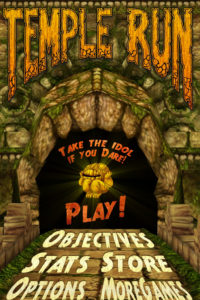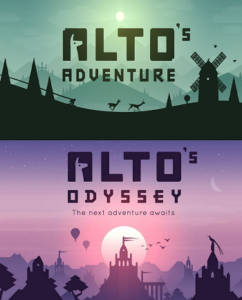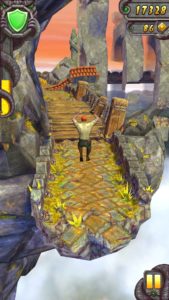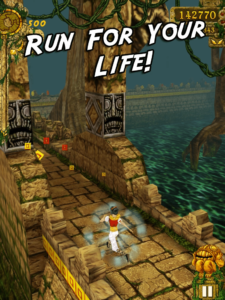

Creator: Imangi Studios, LLC
Alto’s Adventures:
Creator: Snowman
Both:
Platform: iOS, macOS, Android, Windows
Target Audience: New or experienced gamers of age 9+
Temple Run and Alto’s Adventures both fall under the race games genre. While both games have similar mechanics, their aesthetics vary. Both Temple Run and Alto’s Adventures use the racing genre to create their respective aesthetics.

Temple Run is a third-person single-player game where the player runs endlessly around the temple, avoiding obstacles and the gorilla-like monsters chasing him. The player can collect coins along the way and use them for an extra life or other similar rewards. The objective of the game is to “outrun” the monster or at least get a new high score, which is a measure of how long you’ve gone without being captured. The design of the game mimics an ancient, abandoned temple submerged in water and covered by fog. The design is meant to elicit the feeling that something is lurking in the corner. The contrasting colors, rigid structure, and sharp corners keep you guessing. The rough soundtrack further adds to the suspense of the game. The outcome is always the same (as far as I’m concerned): you always get caught.
Temple Run creates the aesthetics of Discovery, Challenge, and Sensation. The unknown structure of the temple and the feeling of something lurking around the corner enforces the discovery aesthetics of this game. The challenge of the game arises in how long a player is able to hold off the monsters. Third, the visual and audio media employed in the game create suspense, which meets the sensation aesthetics of this game.

The way the main character is running, it be like he’s running for his life. This definitely adds to the race genre cause you know you gotta run. Even the game tells you: “RUN FOR YOUR LIFE!” You better believe I’m running for my life when I play Temple Run.
Alton’s Adventures is also a third-person single-player game where the player is chasing after Alto’s escaping llama. The player can collect coins along the way and can later exchange them for “cool things at Izel’s workshop back in the village.” The mechanics include pressing on the screen to do tricks on the snowboard and tapping on the screen to jump over an obstacle. Like Temple Run, this game has you snowboarding endlessly. Completion of a level is determined by pre-determined goals (i.e. how many llamas’ collected or the total distance traveled). The design of Alto’s Adventures mimics a snowy mountain top. Unlike Temple Run, the colors are soft and bright, and the surfaces are smooth, which matches the soothing soundtrack. It’s very visually pleasing.

Like Temple Run, Alto’s Adventures creates the aesthetics of Discovery, Challenge, and Sensation. The different levels and new surroundings create the discovery aesthetics of this game. The challenge arises from the urgency one feels to get all the llamas and stay alive for as long as possible. And like Temple Run, the visual and audio sources in Alto’s Adventures create a sensation aesthetics of this game.
Overall, both racing games were engaging but Temple Run’s use of the monsters as motive and its harsh graphic design justify the running slightly more than the lightheartedness of that of Alto’s Adventure for me.


